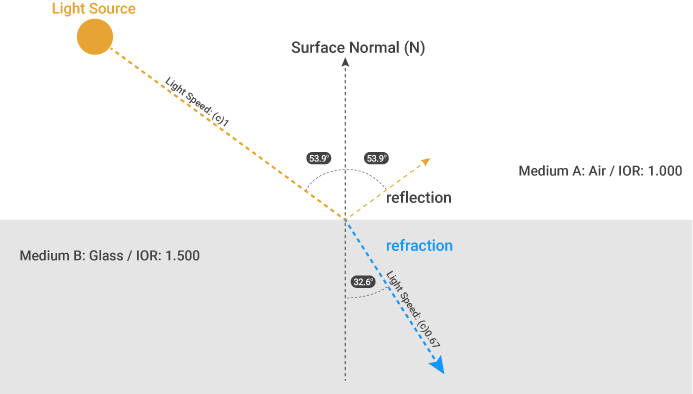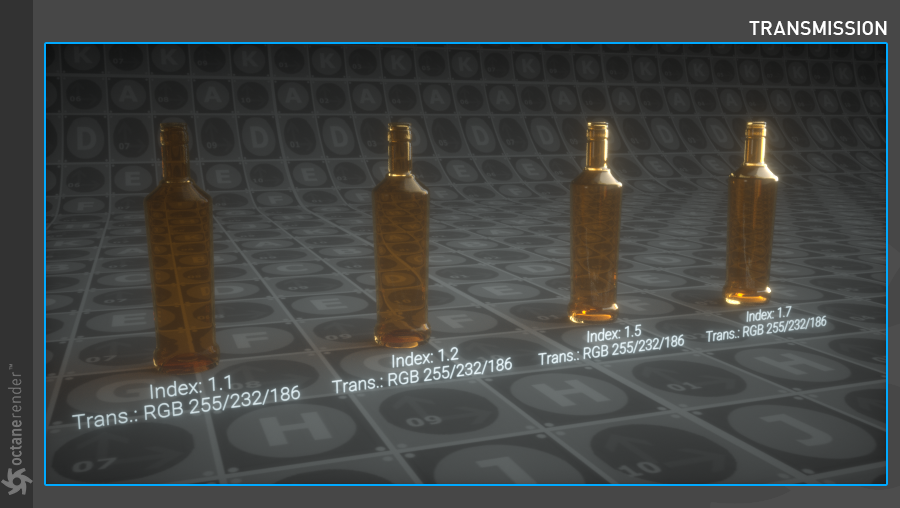SPECULAR MATERIAL
In its simplest form, it is used to create transparent materials such as water or glass. The most difficult, but most enjoyable type of material to study. The difficulty is due to the interaction of light with the surface. As we have already mentioned, when light hits a surface, it is reflected or absorbed or refracted. Usually this three works together but when the light hit, it changes its behavior when it enters from one medium (for example air) into another medium (for example glass). These changes depend on the optical and topological properties of the surface. In Specular Transmission, when light enters another medium, it reduces speed, changes direction and bends. That's why we can see the result of the light movement on surfaces such as glass and water. Let's also emphasize the importance of the index of refraction (IOR) factor here and try to explain it better.
镜面材质
它以最简单的形式用于创建透明的材质,例如水或玻璃。最困难但最有趣的学习材质。困难是由于光与表面的相互作用。正如我们已经提到的,当光撞击表面时,它会被反射,吸收或折射。通常,这三个一起工作,但是当光线照射时,当它从一种介质(例如空气)进入另一种介质(例如玻璃)时,其行为就会改变。这些变化取决于表面的光学和拓扑特性。在“镜面透射”中,当光进入另一种介质时,它会降低速度,改变方向并弯曲。这就是为什么我们可以看到光在玻璃和水等表面上移动的结果的原因。我们还要在这里强调折射率(IOR)因子的重要性,并尝试对其进行更好的解释。
First, let's assume that the light in the air (or under vacuum) enters the water. In such case, a large part of the light enters the water and continue to its travel, and some of it is reflected by the water. Inside the water, the light continues to bend.
首先,让我们假设空气中(或在真空下)的光进入水中。在这种情况下,很大一部分光线会进入水中并继续行进,而有些光线会被水反射。在水中,光线继续弯曲。

Now suppose that the same light enters the glass this time. As you can see the light entering the surface, changes its angle and continues to bend.
现在假设这次有相同的光进入玻璃。 如您所见,光线进入表面,改变其角度并继续弯曲。

So why does the light behave this way? The reason for this bend is due to the Refractive Index. In this case, the Transmission case should not be considered without the Refractive Index. The refractive index (or index of refraction) of a medium is a measure for how much the speed of light is reduced inside the medium. In other words, the refractive index is the ratio of light velocity in air (or vacuum) to its velocity in the transmitting medium. For example, a typical glass has a refractive index of 1.5, which means that light travels at 1.5 times slower than in the air or vacuum. As this value increases, the rate of refraction increases. As the refraction rate increases, the velocity of the light in the medium decreases.
As you can see, IOR value is a very important parameter. Therefore, knowing the true IORs of transparent materials will be a good step in creating realistic material. You can find the actual IOR information of the relevant material from this site which we mentioned earlier.
那么,为什么光会以这种方式表现呢?弯曲的原因是由于折射率。在这种情况下,不考虑没有折射率的透射情况。介质的折射率(或折射率)是介质内部光速降低多少的度量。换句话说,折射率是空气(或真空)中的光速与其在传输介质中的速度之比。例如,典型的玻璃的折射率为1.5,这意味着光的传播速度比空气或真空中的传播速度慢1.5倍。随着该值的增加,折射率也增加。随着折射速率的增加,介质中的光速降低。
如您所见,IOR值是一个非常重要的参数。因此,了解透明材质的真实IOR将是创建实际材质的好步骤。您可以从我们前面提到的该站点中找到相关材质的实际IOR信息。
Now let's look at Octane's Specular material options. We will not explain the parameters that we have already explained in Diffuse or Glossy section. When you select Specular, some new parameters will appear. We will only explain these new parameters.
现在,让我们看一下Octane的Specular材质选项。我们不会解释“漫反射”或“光泽”部分中已经说明的参数。选择“镜面反射”时,将出现一些新参数。我们将仅解释这些新参数。

REFLECTION
By using this parameter you can control the reflection strength on your specular surface. Most specular transmission surfaces have a reflection depending on the surface properties. In other words, these surfaces shows both reflective and transmission properties. Here you can enter the reflection value from this parameter. Be careful not to enter high values like the reflection strength in the glossy material. In such case, the photons will hit the surface and reflect back and will not be able to penetrate the medium as much as necessary. You will get results for sure, but it may not seem like it should be. You can enter RGB, Float value and Texture for the amount of reflection. In the following image, the float value is used in the reflection. Reflect source is the environment HDR.
反射
通过使用此参数,可以控制镜面反射强度。 大多数镜面透射表面会根据表面属性产生反射。 换句话说,这些表面既显示反射特性又显示透射特性。 您可以在此处输入此参数的反射值。 注意不要在光泽材质中输入诸如反射强度之类的高值。 在这种情况下,光子将撞击表面并反射回来,并且将无法尽可能多地穿透介质。 您肯定会得到结果,但看起来可能并非如此。 您可以输入RGB,浮点值和纹理作为反射量。 在下图中,在反射中使用了float值。 反映源是环境HDR。

DISPERSION
Dispersion is that the index of refraction for most materials are actually a function of the wavelength of the light. When you send in white light composed of all visible wavelengths, the colors will disperse and get separated from each other. That's called "separation of light dispersion". Each visible wavelength has a slightly different index of refraction. For example, In the below picture the index of refraction of red light for clear glass is about 1.50 but the index of refraction of blue light is closer to about 1.51. In fact, for most materials the smaller the wavelength of the light the larger the index of refraction which means smaller wavelength light will bend more than larger wavelength light. Look at the prism below.
For dispersion values of some glass materials, you can also visit refractiveindex.info. You can also go to this link for a more detailed article on Dispersion.
色散
色散是大多数材质的折射率实际上是光波长的函数。 当您发送由所有可见波长组成的白光时,颜色将分散并彼此分离。 这就是所谓的“光色散分离”。 每个可见波长具有略微不同的折射率。 例如,在下图中,透明玻璃的红光折射率约为1.50,而蓝光的折射率则接近于1.51。 实际上,对于大多数材质而言,光的波长越小,折射率越大。这意味着较小波长的光将比较大波长的光弯曲更多。 看下面的棱镜。 有关某些玻璃材质的色散值,您也可以访问fractureindex.info。 您也可以转到此链接以获取有关分散的更详细的文章。


INDEX
We will not repeat the Index, which we have previously described in the Glossy section and at the beginning of this section. Only with the information above, we would like to show how slow the light when you increase the IOR values. We would also add that this value works effectively with Transmission. You can read more detailed information in the Transmission section.
指数
我们将不再重复前面在“光泽度”部分和本节开头所述的索引。 仅使用以上信息,我们才想显示增加IOR值时光线的缓慢程度。 我们还要补充一点,该值可与Transmission有效地配合使用。 您可以在“传输”部分中阅读更多详细信息。

TRANSMISSION
This parameter controls how the light passes from the surface (more precisely, expressed as the ratio of the speed of light to the refractive index). They are tightly linked with Index and work together. We have explained in previous articles that when light enters a medium it moves slower than it's in the air (or vacuum). Here you can check this by using Texture / Greyscale or RGB value in Transmission. As you can see in the picture below, the movement of the light inside the bottle is shown using greyscale values. When you look at the bottle on the far left, the light actually moves 1.1 times slower than it is in the air. So we almost barely see the bottle. In other bottles, you can see the differences in the passage of light through the bottle by playing with both transmission and IOR values.
传输
此参数控制光从表面通过的方式(更确切地说,表示为光速与折射率之比)。 它们与Index紧密联系在一起并一起工作。 我们在之前的文章中已经解释过,当光进入介质时,它的移动速度要比空气(或真空)中的移动速度慢。 您可以在此处使用“传输”中的“纹理/灰度”或“ RGB”值进行检查。 如下图所示,瓶子内部的光的移动是使用灰度值显示的。 当您查看最左侧的瓶子时,灯光的移动速度实际上比空气中的移动速度慢1.1倍。 所以我们几乎看不到瓶子。 在其他瓶子中,您可以通过同时测量透射率和IOR值来查看光在瓶子中通过的差异。

In the picture below, an RGB value is used. When you look at the bottle on the far left, the light is still 1.1 times slower than it's in the air, but the RGB value makes the bottle look a bit more visible. This is because some wavelengths of the light have more bend as the angle changes. For example, since the orange color is relatively low wavelength, the light is more distorted in this wavelength than the previous one. In other bottles, you can see the differences in the passage of light through the bottle by playing with both transmission RGB and IOR values.
在下图中,使用了RGB值。 当您查看最左边的瓶子时,光线仍然比空气中的光线慢1.1倍,但是RGB值使瓶子看起来更清晰可见。 这是因为随着角度的变化,某些波长的光会弯曲更多。 例如,由于橙色是相对较低的波长,因此在此波长下的光比前一个波长更失真。 在其他瓶子中,您可以通过同时查看透射RGB和IOR值来查看光线通过瓶子的差异。

FAKE SHADOWS
Fake Shadows is a Boolean value that activates architectural glass option for all meshes sharing that material. When enabled, the specular material exhibits the characteristics of Architectural glass with its transparent feature allowing light to illuminate enclosed spaces or frame an exterior view. If you want a realistic shadow for your specular material, you can turn this option off. If you turn it off, your render may be noise based on your scene structure. In such case, use this option carefully as you will have to enter extra samples to reduce the noise. For example, you can turn it on this option for distant objects, but you can turn it off for close and detailed specular material.
假影
“假阴影”是一个布尔值,可为共享该材质的所有网格激活建筑玻璃选项。 启用后,镜面反射材质将具有建筑玻璃的特性,并具有透明功能,使光线可以照亮封闭的空间或构成外部视图。 如果要为镜面反射材质提供逼真的阴影,可以关闭此选项。 如果将其关闭,则根据场景结构,渲染可能会产生噪点。 在这种情况下,请谨慎使用此选项,因为您将不得不输入额外的采样以降低噪波。 例如,您可以为远处的对象启用此选项,但可以关闭以获取详细的镜面反射材质。












赶快留个言打破零评论!~